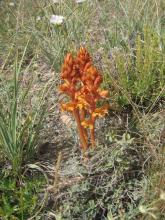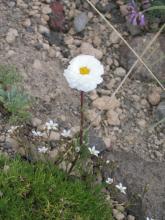(I have shown some of these pictures before)
Two years ago a friend of me and I decided to explore eastern Turkey and ascend Mt Ararat if possible. We met our guide in the city of Van at the shore of the lake and set out by car for the crater, lake and ridge of the name of Nemrut ( http://en.wikipedia.org/wiki/Nemrut_(volcano) ) at the other side of the lake to start the acclimatisation process.
We spent the night at the shore of a small, warm body of water near the bigger Nemrut lake. The next morning we went along the ridge (highest point 3050m). A long, but easy walk at the rim. Interesting plants everywhere.
1) View of lake Van
2) We spent the night here (in tents).
3) I noticed many wilted bulbous plants among the grass and Lady's Bedstraw (Galium verum).
4-5-6) Lake and caldera. A birch and oak wood along the shore.
7) When we walked along the ridge we were suddenly caught by a rain and hail storm. We wore shorts and summer clothing as it had been very hot when we started. Although the shower did not last long, it was ice cold. Fortunately I had raingear in my small rucksack.
Comments
Re: Land of Noah, flowers but no flooding
On the next leg we went to the Suphan area. Mt Süphan is the second highest in Turkey, 4058m. We drove to the foot of the mountain and camped. Early morning, it was still dark we started for the summit. The ground was rock, sand and gravel and grass.
1) When the daylight came we had still some way to go.
2) Upwards.
3) The glacial sediments is perfect for the plants! Arabis caucasia?
4) Bellis perennis look-alike.
5) Jurinella?
6) Campanula aucheri and lots of other plants.
7) Drabs sp It is many species in this genus in Turkey.
8.) Tanacetum kotschyii?
9) Myosotis sp
10) Numerous different species of Fabaceae and Caryophyllaceae clothed the mountain side.
Re: Land of Noah, flowers but no flooding
Some great looking plants there Trond! I'm envious of such travels. In the last photo labeled Fabaceae and Caryophyllaceae.JPG, the pale pink Caryophyllaceae with darker eyes looks much like Gypsophila briquetiana which I grew from the MacPhail & Watson expedition to Turkey in the late 1970s. The blue flowers, might they be a Polygala? Love the Jurinella, something I got seed of in the Mac&W expedition, but failed to grow. I believe you showed the yellow draba before, is it D. araratica? Whatever it is, it's a beauty, highly photogenic growing out of a rock crack.
Re: Land of Noah, flowers but no flooding
Mark, The pink plant may well be Gypsophila briquetiana. I had no flora at the time I was there, and it is difficult to conclude from pictures alone, it's a wealth of different species and each mountain has its own flora. Regarding the Draba I found some at Suphan and others at Ararat. Holubec and Krivka mention D. araratica from Ararat, not from Suphan. Small yellow Drabas are very similar! The blue flower is not a polygala, I am certain of that (the picture is a little out of focus).
Here are some more from Suphan. On our way down a thick wall of fog, or rather a cloud, came and engulfed us. For 1/2 hour we lost the faint track (seemingly almost no people walk here). Fortunately we found it before we entered a dangerous scree.
Re: Land of Noah, flowers but no flooding
The last leg. We headed for Mt Ararat.
1) Even if it is very dry, there are some rivers. Here a rapid.
2) A small museum was built near the place where Noah's Ark was "found". Interesting case, but I do not believe this is the Ark. http://www.bibleplus.org/discoveries/noahsark.htm
3) In view: Mt Ararat behind an Onopordium acanthum.
4) Almost all the lower slopes of the mountains were grazed by animals like cattle, sheep, goats and horses. As a result different kinds of grasses dominated.
5) We hired nomads with horses to carry our stuff higher up.
6) Pedicularis sp.
Re: Land of Noah, flowers but no flooding
Higher up there are fewer grazing animals and you find flowering plants.
1) Nepeta supina
2) Veronica telephiifolia
3) Cerastium sp
4) Draba araratica?
5) Campanula aucheri in the middle of the path
6) Last view of Mt Ararat
Re: Land of Noah, flowers but no flooding
I'm enjoying your photos very much, Trond! What amazing trips you have gone on!
Re: Land of Noah, flowers but no flooding
Beautiful pictures, Trond. How lucky you were to see Campanula aucheri blooming like that, really sensational.
Re: Land of Noah, flowers but no flooding
Lori, Yes I have been on some very interesting trips. It is very cheap for us to travel abroad, everywhere the prices are lower than at home. I travel with one or two friends and we buy from small companies at the internet. We never have been cheated. I can't go every year, have to look after my family too! We choose other destinations when we travel as a family.
Anne, Campanula aucheri is one of the bluest plants I have ever beheld! When we visited those part of Turkey large patches of the sandy soil ( about 3800m) especially at Suphan were covered by them. Our guide said that he never had seen such flowering. We were lucky arriving at the right time after snowmelt.
Re: Land of Noah, flowers but no flooding
Unreal trip Trond! The scenery is spectacular and the alpines sublime! Some really choice plants there....but then Turkey is full of wonderful alpines...most which are useless in my wet climate! Drat!




Here are some of the plants we noticed along the rim. I am sorry I had not much time to take photographs.
(More to follow)